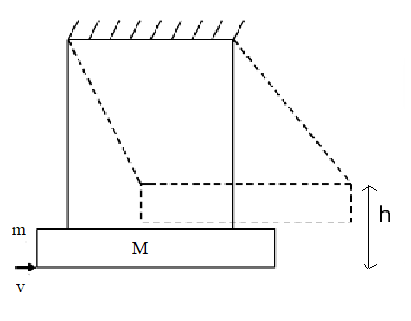
A large block of wood of mass M = 5.99 kg is hanging from two long massless cords. A bullet of mass m = 10 g is fired into the block and gets embedded in it. The (block + bullet) then swings upwards, their centre of mass rising a vertical distance h = 9.8 cm before the (block + bullet) pendulum comes momentarily to rest at the end of its arc. The speed of the bullet just before the collision is: (take g = $9.8\,m{s^{-2}}$)

A. 831.4 m/s
B. 841.4 m/s
C. 811.4 m/s
D. 821.4 m/s
Answer
220.5k+ views
Hint:To solve this question we use conservation of energy which means that energy before collision and energy after collision will be equal to the value of velocity after collision. By using velocity and applying conservation of momentum we get the required result.
Formula used:
Conservation of energy is given as:
\[(M + m)gh = \dfrac{1}{2}(M + m){v_1}^2\]
Where \[{v_1}\] is the velocity after collision, g is the acceleration due to gravity and h is the height.
Complete step by step solution:
According to energy conservation,
\[(M + m)gh = \dfrac{1}{2}(M + m){v_1}^2\]
After solving this, we get
\[{v_1} = \sqrt {2gh} \]
Also according to the conservation of momentum,
\[mv = (M + m){v_1}\]
\[\Rightarrow v = \left( {\dfrac{{M + m}}{m}} \right){v_1}\]
By solving this we get the result
\[\therefore v = 831.4\,m/s\]
Hence option A is the correct answer.
Note: Energy conservation is defined as the decision or practice of using less amount of energy. When we leave the room, we turn off all the lights or unplug appliances when they're not in use and we prefer walking instead of driving. All these are examples of energy conservation. In any closed system that is isolated from its surroundings then the total energy of that system is said to be conserved.
Formula used:
Conservation of energy is given as:
\[(M + m)gh = \dfrac{1}{2}(M + m){v_1}^2\]
Where \[{v_1}\] is the velocity after collision, g is the acceleration due to gravity and h is the height.
Complete step by step solution:
According to energy conservation,
\[(M + m)gh = \dfrac{1}{2}(M + m){v_1}^2\]
After solving this, we get
\[{v_1} = \sqrt {2gh} \]
Also according to the conservation of momentum,
\[mv = (M + m){v_1}\]
\[\Rightarrow v = \left( {\dfrac{{M + m}}{m}} \right){v_1}\]
By solving this we get the result
\[\therefore v = 831.4\,m/s\]
Hence option A is the correct answer.
Note: Energy conservation is defined as the decision or practice of using less amount of energy. When we leave the room, we turn off all the lights or unplug appliances when they're not in use and we prefer walking instead of driving. All these are examples of energy conservation. In any closed system that is isolated from its surroundings then the total energy of that system is said to be conserved.
Recently Updated Pages
Two discs which are rotating about their respective class 11 physics JEE_Main

A ladder rests against a frictionless vertical wall class 11 physics JEE_Main

Two simple pendulums of lengths 1 m and 16 m respectively class 11 physics JEE_Main

The slopes of isothermal and adiabatic curves are related class 11 physics JEE_Main

A trolly falling freely on an inclined plane as shown class 11 physics JEE_Main

The masses M1 and M2M2 M1 are released from rest Using class 11 physics JEE_Main

Trending doubts
JEE Main 2026: Application Form Open, Exam Dates, Syllabus, Eligibility & Question Papers

Understanding Uniform Acceleration in Physics

Derivation of Equation of Trajectory Explained for Students

Hybridisation in Chemistry – Concept, Types & Applications

Understanding the Angle of Deviation in a Prism

How to Convert a Galvanometer into an Ammeter or Voltmeter

Other Pages
Thermodynamics Class 11 Physics Chapter 11 CBSE Notes - 2025-26

JEE Advanced Marks vs Ranks 2025: Understanding Category-wise Qualifying Marks and Previous Year Cut-offs

Units And Measurements Class 11 Physics Chapter 1 CBSE Notes - 2025-26

NCERT Solutions For Class 11 Physics Chapter 8 Mechanical Properties Of Solids

Motion in a Straight Line Class 11 Physics Chapter 2 CBSE Notes - 2025-26

Laws of Motion Class 11 Physics Chapter 4 CBSE Notes - 2025-26




